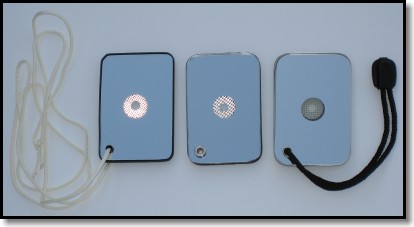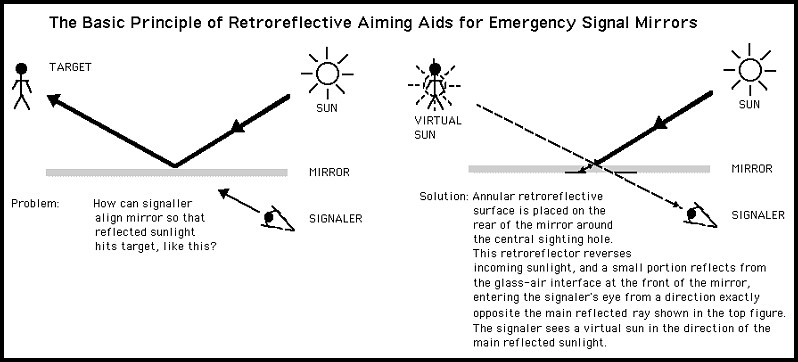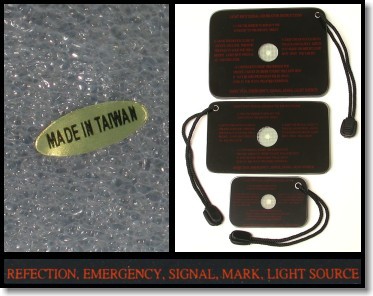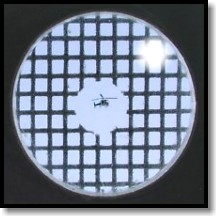

 |
 |
While relatively fragile and heavy, glass signal mirrors are the gold standard for reflectivity, against which we measure others. Many still prefer them to even the best plastic signal mirrors. There are two types of laminated glass signal mirrors commonly available in the U.S., ones made in the U.S. in conformance to the old
 |
| L to R: S.I. Howard, Vector 1, Taiwanese Fake. Note reflection of camera flash in first two from retro-reflective aimer, compared to fake. |
(Click here for illustrated instructions on how to use a retro-reflective mesh one-hand aimer).
Recently an associate who collects signal mirrors and who is a student of their history emailed me about a bunch of phony glass signal mirrors that have suddenly hit the market. They appear to be poorly constructed copies of the Vector 1 signal mirrors (though they may well have copied some other similar mirror available overseas) with the two pieces of glass often misaligned and a much less substantial aluminum rivet in the lanyard hole (the S.I. Howard mil-spec mirrors have no rivet). Beyond the lesser quality construction, and of much more concern, these fakes appear to have a mesh retro-reflective aimer, but it is nothing more than a printed imitation done in silver ink. It is NOT retro-reflective and it does not work (this isn't the first time; for a number of years Skyblazer sold a plastic signal mirror with a similar fake aimer). In my opinion, the only apparent function of the fake mesh is to fool people into thinking they are buying a mirror with a genuine retro-reflective one-handed aimer.
The images below show the differences between the real retro-reflective aimers, which are created by gluing tiny glass beads to real mesh, and the printed fake (left to right: S.I. Howard, Vector 1, Printed fake).

The faux signal mirrors appear to all be from the same Taiwanese source and are being distributed by Rothco, Atlanco, and Fox Outdoor Products. There may be others. (Atlanco formerly distributed the Vector 1 mirror, but no longer does so according to Vector 1.) We purchased samples of the Atlanco 2" x 3", 3" x 5" and 4" x 5" and Rothco 3" x 5" mirrors from Silberman's Army and Navy, which is online as www.workinggear.com.
The descriptions on the site (and other sites online that we checked) are not forthcoming about the mirrors' failings and are pretty misleading, without being outright false advertising. That is in part because there is no legal definition of a signal mirror as having a working one-hand usable aimer and the term "signal mirror" has been used indiscriminately for years for a wide range of mirrors, many of which do not have any manner of one-handed aimer.
Some descriptions online utilize the term "relfectorized screen" (sic) or "reflectorized screen" to describe the aimer. Since "reflectorized" generally seems to be used to denote something that reflects light, but is occasionally also used to denote something that is retro-reflective, that also isn't a lie, just confusing and misleading. After all, most buyers have no idea what the differences are between reflective and retro-reflective.
Just to be clear, "retro-reflective" means that the light is reflected back to the source. A mirror, or any shiny surface, is simply "reflective," which is why we can take the sun's light and send it off in another direction to signal with. A common example of retro-reflectivity would be road signs which are illuminated back at you when your car's headlights light them up, regardless if you are directly in front or they are overhead or approached at an angle. In a somewhat unintuitive manner, the glass beads of the retro-reflective signal mirror aimers utilize this capability to create a false image of the sun where the mirror will reflect light towards. This is the fireball you see and aim with.

Click here to view the original patent for using these glass beads to create a retro-reflective aimer.
(Document in Adobe Acrobat PDF format. Get Free Acrobat (PDF file) Reader)
On the other hand, one could argue that the mirrors themselves are defective and fraudulent because it isn't possible to use them in accordance with the instructions for use printed on the back of the faux mirrors. Regardless of how poorly they are written in somewhat fractured English, the instructions still assume that the aiming grid will function as it would if it was retro-reflective, and of course, it doesn't. So, whether or not you consider the sale of the mirrors as "signal mirrors" to be misleading, the fact is that the mirrors themselves are, at the least, defective in this regard in my opinion. Unfortunately the FTC has bigger fish to fry, so it's not like they are likely to do anything about these defective lifesaving devices.
 How do you tell if the glass signal mirror you got is a fake or real? Readily identifiable marks of the fake mirrors include a gold sticker with the text "MADE IN TAIWAN" on the foam packaging, "REFECTION, EMERGENCY, SIGNAL, MARK, LIGHT SOURCE" in a serif font on the back of the mirror (Note the misspelling of the first word), and a short black polyester cord lanyard ending in a black plastic pull tab.
How do you tell if the glass signal mirror you got is a fake or real? Readily identifiable marks of the fake mirrors include a gold sticker with the text "MADE IN TAIWAN" on the foam packaging, "REFECTION, EMERGENCY, SIGNAL, MARK, LIGHT SOURCE" in a serif font on the back of the mirror (Note the misspelling of the first word), and a short black polyester cord lanyard ending in a black plastic pull tab.
The real signal mirrors are marked on the back with the mil-spec, "MIL-M-18371E", in the case of S.I. Howard, or "MADE In JAPAN", in the case of Vector 1.
 You can also take it out in the sun and quickly determine if the aimer really works. Face the sun with the reflective side away from you and hold the mirror up to your eye. Hold your hand up in front of you and shine the mirror's reflection on your hand. Look through the mesh of the aimer at the reflection (not through the clear hole in the center) and within the mesh should be a very bright small hot spot of light (often referred to as a "fireball") that looks something like that shown in the illustration to the left. If you don't see a fireball, it's a fake. Don't mistake the reflection of the mirror on your hand or the ground for the "BRIGHT LIGHT SPOT" that is referenced in the instructions on the back of the fake mirrors. Click here for illustrated instruction for testing your aimer in this manner, courtesy of my signal mirror collector associate.
You can also take it out in the sun and quickly determine if the aimer really works. Face the sun with the reflective side away from you and hold the mirror up to your eye. Hold your hand up in front of you and shine the mirror's reflection on your hand. Look through the mesh of the aimer at the reflection (not through the clear hole in the center) and within the mesh should be a very bright small hot spot of light (often referred to as a "fireball") that looks something like that shown in the illustration to the left. If you don't see a fireball, it's a fake. Don't mistake the reflection of the mirror on your hand or the ground for the "BRIGHT LIGHT SPOT" that is referenced in the instructions on the back of the fake mirrors. Click here for illustrated instruction for testing your aimer in this manner, courtesy of my signal mirror collector associate.
For those interested, some sources for the mil-spec S.I. Howard signal mirrors that we have found (pricing as of 11/29/2008) are:
(This listing is not all inclusive. If you know of other sources, please email me with the information - listing here does not necessarily imply an endorsement)
The Coghlan's brand Vector 1 signal mirrors are sold by Walmart, REI, and many sporting goods stores.
|
| SELECT AND USE OUTDOORS AND SURVIVAL EQUIPMENT, SUPPLIES AND TECHNIQUES AT YOUR OWN RISK. Please review the full WARNING & DISCLAIMER about information on this site. |
Publisher and Editor: Doug Ritter
Email: Doug Ritter
URL:
http://www.equipped.org/phony_signal_mirrors.htm
First Published: November 23, 2008
Revision: 01 February 11, 2011
|